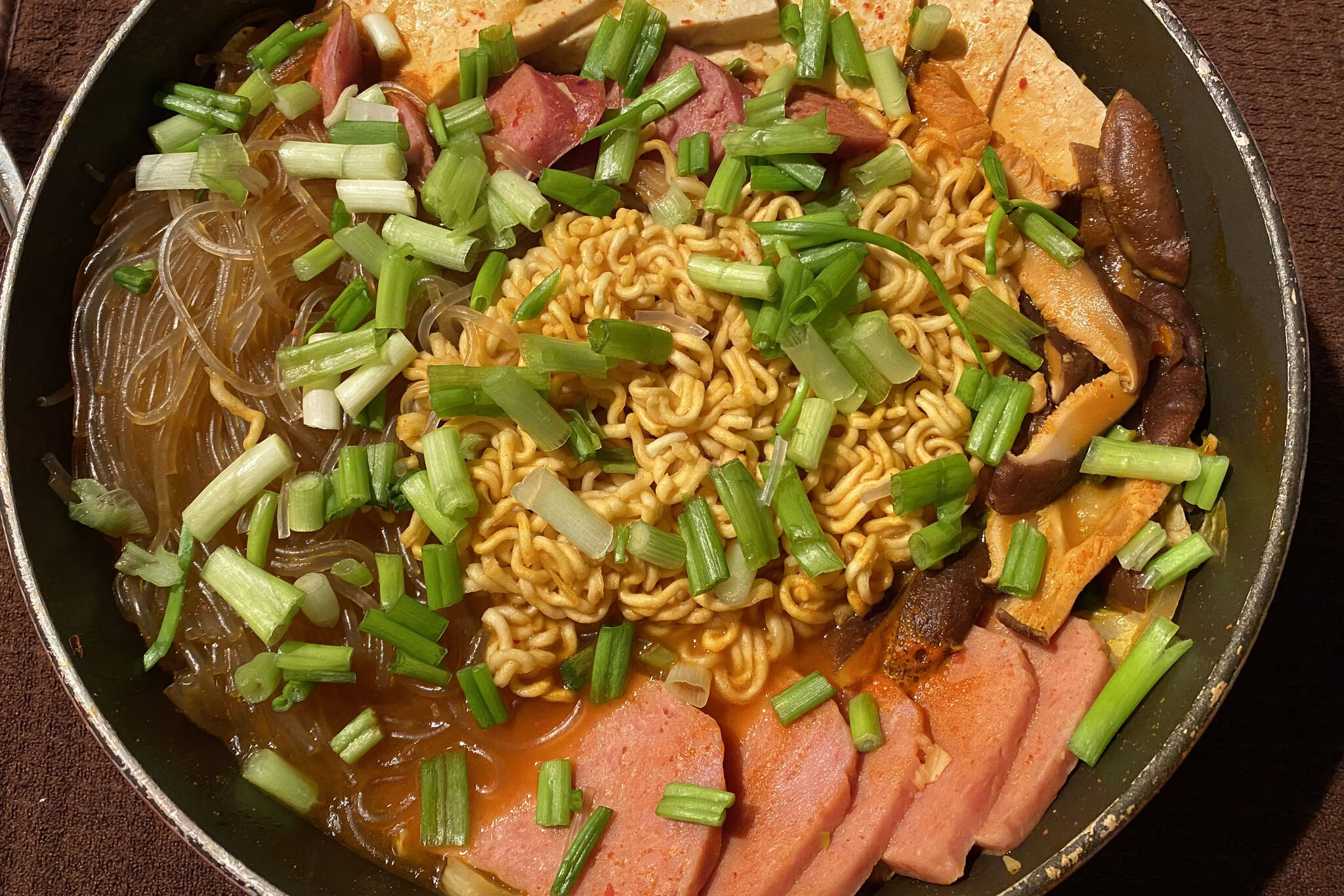On a freezing, gusty Saturday in January, my sister and I were out exploring in Seoul, South Korea. We had spent the afternoon shopping in an enormous outdoor market just outside the ancient east gate of the city. After hours of traversing the narrow, bustling alleys in the frigid cold and wind, we went out in search of something spicy and boiling hot to take the chill out of our bones.
One of our teachers had told us about a restaurant outside of Yongsan that was famous for a unique dish created during the Korean war, when American soldiers introduced local cooks to some American staple ingredients of the time: Spam and hotdogs.
Ingredients:
1 cup cabbage kimchi, chopped
1 cup napa cabbage, chopped into bite sized pieces
1⁄2 cup sliced white onion
2 tablespoons minced garlic
4 stalks green onion, in ½ inch long pieces
½ packet of dry ramen (I used Korean ramyun)
Potato starch noodles — around 2 ounces or about 1 cup after soaking until soft
1⁄3 can of Spam, thinly sliced
¼ block of firm tofu, thinly sliced
1⁄3 package of beef or pork kielbasa sausage (or 2 hotdogs)
1 tablespoon Korean red pepper paste
1-2 teaspoons Korean red pepper powder (optional, for extra spice)
1 teaspoon sugar (optional, but recommended for flavor)
1⁄3 cup dried shitake mushrooms or 4 large fresh shitake mushrooms
3-5 cups vegetable or chicken stock
Directions:
Soak your mushrooms and potato starch noodles in water until soft. Strain the noodles and set aside. Strain the mushrooms and squeeze out the excess water, slice into bite-sized pieces, then set aside.
Slice your spam and tofu into equal, thin slices and set aside.
Slice your sausage or hotdogs diagonally into ½ inch thick slices and set aside.
In a large, shallow pan arrange your kimchi and vegetables (except the mushrooms and green onions) to cover the bottom in an even layer.
Mix your red pepper paste (and powder, if using) with 1 cup of broth until liquefied and pour over the vegetables.
Arrange your meats, tofu, mushrooms, dry ramen noodles, and soaked potato starch noodles artfully around the pan. Everything should be in a single layer, so all the ingredients are visible. The cooking pan will also be the serving vessel.
Pour stock into the pan until it is about halfway full. Some ingredients will not be fully submerged.
Put the pan on high heat and let it come to a boil.
Periodically spoon some boiling broth over the noodles, careful not to mix or disturb the ingredients.
When the ramen is cooked, top with green onions and take off the heat.
Move the pan immediately to the table (make sure to use hot pads to protect your surface) and dig in.
If you happen to have a camp stove, you might consider cooking the dish at the table like they do in Korea. Sitting together and chatting while the dish cooks is most of the fun of it. This is best served with an array of vegetable side dishes like seasoned bean sprouts, seasoned spinach, broccoli salad and pickled radish. This meal is junky and full of sodium and fat so don’t skip the vegetables and save it for after a long day outside in the cold.
I want to take this opportunity to thank all the hard-working employees of Homer Electric for working around the clock in the dreadful weather to restore our heat and lights this weekend. I was so grateful when the lights came on in the middle of the night, I jumped out of bed to move the frozen milk on the porch inside so my son could have milk with his breakfast. I wish I could share this meal with you all to thank you properly.
Tressa Dale is a culinary and pastry school graduate and U.S. Navy veteran from Anchorage. She lives in Nikiski with her husband, 2-year-old son and two black cats.

